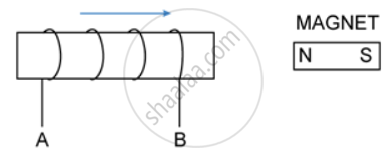Advertisements
Advertisements
प्रश्न
In the following diagram an arrow shows the motion of the coil towards the bar magnet.
(1) State in which direction the current flows, A to B or B to A?
(2) Name the law used to come to the conclusion.

उत्तर
(1) The direction of current in the coil is from A to B.
(2) The law used is the Lenz’s law of electromagnetic induction.
The coil is moving towards the North Pole of the magnet. Due to this, there is a change in magnetic flux in the coil. Now, the direction of induced e.m.f. (induced current) is such that it opposes this change in flux. Hence, the right end of the coil should also behave as North Pole. Hence, the current will be in the anti-clockwise direction, i.e., from A to B.
APPEARS IN
संबंधित प्रश्न
State Faraday's laws of electromagnetic induction.
- How would you demonstrate that a momentary current can be obtained by the suitable use of a magnet, a coil of wire and a galvanometer?
- What is the source of energy associated with the current obtained in part (a)?
What is Lenz’s law?
Why does it become more difficult to move a magnet towards a coil when the number of turns in the coil has been increased?
The diagram in shows a coil of several turns of copper wire near a magnet NS. The coil is moved in the direction of arrow shown in the diagram.

- In what direction does the induced current flow in the coil?
- Name the law used to arrive at the conclusion in part (i).
- How would the current in coil be altered if
- the coil has twice the number of turns,
- the coil was made to move three times fast?
An electron moves on a straight line path XY as shown. The abed is a coil adjacent to the path of electron. What will be the direction of current, if any, induced in the coil?

Magnetic flux passing through a coil is initially 6 x 10-4 Wb. It reduces to 10 % of its original value in 't' second. If the e.m.f. induced is 0.54 mV then 't' in second is ____________.
A D.C generator works on the principle of ____________.
For which angle between two equal vectors `vec"A"` and `vec"B"` will the magnitude of the sum of two vectors be equal to the magnitude of each vector?
